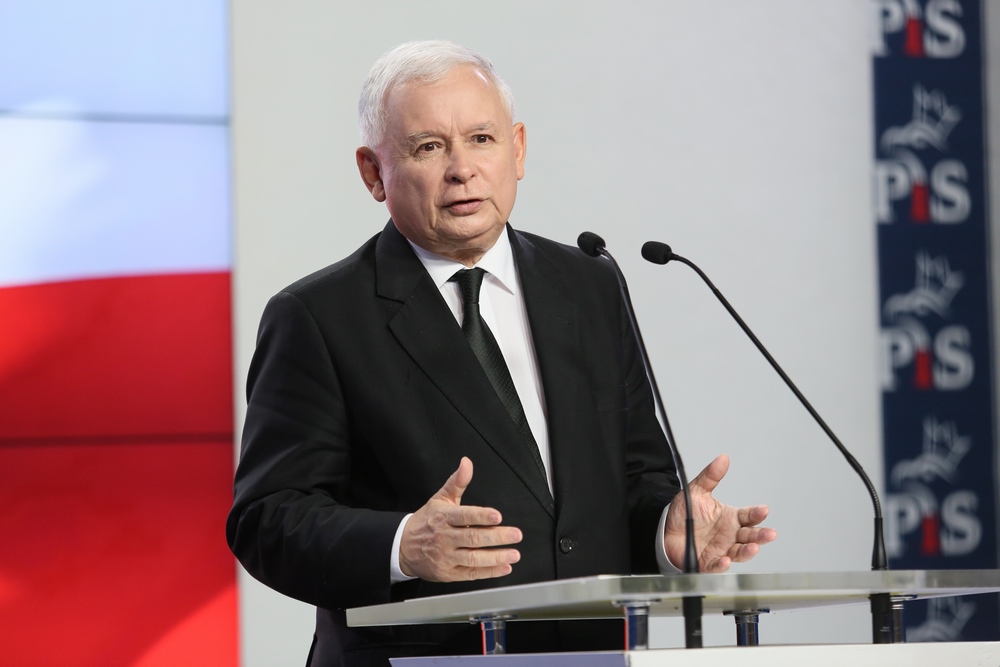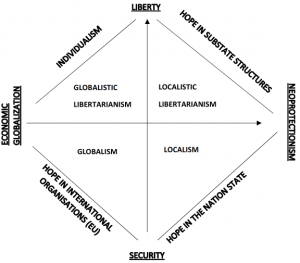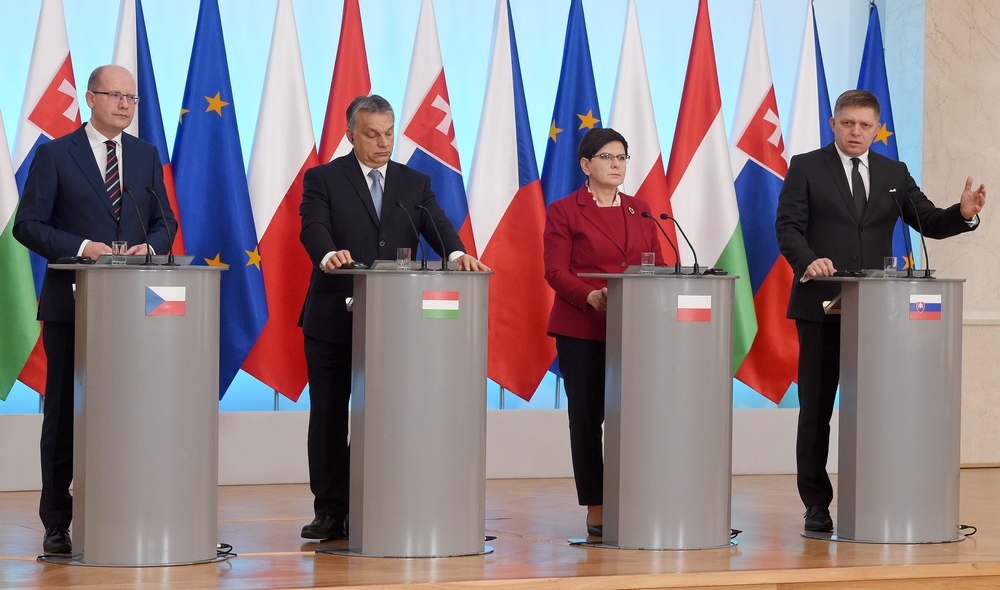THE WARSAW INSTITUTE REVIEW
Date: 27 June 2017 Author: Michał Kuź, PhD
Globalism and Localism in the Perspective of Polish Politics
New processes and events on the world political stage are increasingly forcing old labels to be abandoned.

Are Emmanuel Macron and Marine Le Pen, for example, on the right or left? If Donald Trump is a conservative Republican, why did many Republicans look upon his candidacy so skeptically? It was similar with Brexit, which led to divisions among conservatives. Analogous questions arise in East-Central Europe. Since, for example, Law and Justice (PiS) of Jarosław Kaczyński and Fidesz of Viktor Orban, are defined as right-wing parties, sometimes even extreme right, how is that possible that both have introduced the biggest social reforms in their countries in decades, creating new entitlements, especially for large and disadvantaged families?
Towards a new division
The new divisions on the political scene are written about in various ways. The most common terms that appear are mainstream versus nationalism or populism. Nationalism, however, seems inadequate, because not all political movements and parties that are part of the new division focus their attention on the traditionally understood nation-state.
On the other hand, populism, as the definition of the new political tendency, seems completely unsatisfactory because it is a catch-all concept, into which the existing political elites can throw anything that they do not approve of. As rightly noted by Francis Fukuyama: ” ‘populism’ is the label that political elites attach to the policies supported by ordinary citizens that they do not like.”[1] The mythical mainstream is a similarly unclear concept is, that is, the views which the elites like.
The belief in social solidarity — which was formerly characteristic of the left — and the right-wing belief in preserving national, cultural and religious identity, are merging into one localist camp. In opposition to it is the globalist camp, which offers the combination of the old left belief in moral emancipation and the old right-wing, free-market assumptions. This can be grasped in greater detail by comparing some basic political concepts and how they are used by political groups. After examining traditional political parties, Ian Bunge[2] states that from 1945-2008, the following subjects were the most important in their programs:
Table 1
| LEFT | RIGHT |
|
|
Today’s political division can, however, be characterized by a cursory analysis of the beliefs of parties, candidates and political movements in Europe and the USA, as follows:
Table 2
| GLOBALISM | LOCALISM |
|
|
The mere juxtaposition of political slogans does not, however, give a full picture of the new political, ideological spectrum. In order to make this spectrum a bit clearer, however, it is necessary to first define the extremes, the ideological objectives of the various groups, and the vectors of development that are relevant to them. The spectrum created by the globalist-localist axis can be expressed as follows:
Figure 1.[3]

The above chart, similar to the traditional political preference charts it resembles, has two axes. An economic axis and values axis. In case of new divisions, the economic axis spreads primarily between economic globalization and neo-protectionism, which combines the beliefs in job protection with a general pro-social attitude. Somewhat more problematic is the vertical axis, i.e. the safety-freedom axis. It ties into issues such as big data, international terrorism and electronic surveillance. This axis is also characterized by several issues on the border of culture and security. These include migratory waves and a perceived threats to local identity. In general, the security-freedom axis conceptualizes the question: How many of our individual liberties are we willing to give up to the control of bigger and stronger structures in order to secure our prosperity, health and safety? As a result of the addition of this axis, both globalization and localism will have their libertarian variants, thus treating personal freedom as an important value.
Apart from the two axes, the graph also presents four “hopes”, i.e. social structures that, according to certain ideologies, are to be particularly protected and strengthened. For security-oriented localists, such a structure is the nation-state, hence calling them nationalists is not far from the truth. It should be noted, however, that even in their case, it is not the level of nationalism in which the state is absolute and involves itself in all spheres of people’s lives, as was the case with 20th century nationalisms. The new, localist nationalism is more inclined to create a state that protects citizens from outside threats, but leaves them with a relatively broad sphere of personal freedom.
For globalists, however, transnational structures such as the European Union, the World Bank, the UN, the International Monetary Fund, NATO, the International Health Organization, the G7, the G20, and so on, are of key importance. Globalists are strongly convinced that only international cooperation, broadly understood, can ensure order in the present difficult times. It should also be emphasized that globalism is a direct continuation of neo-liberalism, but its goals are even more ambitious, especially in international politics.
In turn, localist libertarianism is growingly distrustful of the traditional nation state and its political role. It displays a fusion of communitarianism and the idea of the city as an important new political subject, which was promoted by the late Benjamin Barber.[4]
On the other hand, globalist libertarians reject both the state and smaller structures as oppressive, while they have faith in the power of the individual, also as an agent of economic activity. They are, in effect, radically pro-capitalist, though they do not necessarily trust supranational structures and the corporations working with them. Globalist libertarianism is thus a continuation of the classical libertarian tradition.
Polish specificity
After 2010, when the echoes of the financial crisis reaching our country revealed the full power of the new divisions, the ideologies of key Polish parties and political movements could be characterized as follows:
Figure 2.

It’s easy to see that the governing PiS party is clearly localist. This was not always the case, during their last period of governance (2005-2007), the party was on the traditional, free-market right. For example, they did not favor social benefits and securing the tax system. And today, an unprecedented reduction in the level of tax evasion and the increase in the level of social security, are among the greatest achievements of this government. It seems that PiS moved to the localist position out of pragmatism. The party was simply looking for a new program to return to power with, after quite a long period (by Polish standards) of liberal and then clearly globalist, Civic Platform governments. Among the smaller parties in the same localist quarter of the chart, is also the centrist agrarian party, PSL, the extreme nationalist party, the National Movement, and the new political movement, Kukiz’15. This last one, however, is a group that is clearly more freedom-oriented than other Polish localists. It is even growing closer to new urban movements, especially those active in the capital and contesting the results of real estate re-privatization activities, including The City is Ours and the Together party.
It should be noted, however, that both of these movements are already localist libertarian groups. They are also defined as the new left, especially the strongly pro-social welfare Together Party (Razem). It should be emphasized, however, that one of the specific features of the new left groups (e.g. the Spanish Podemos or Greek Syriza) is that they no longer have the typical Marxist belief that a different non-neo-liberal globalization is possible. They do not openly strive to build a new international, so out of necessity they have to be politically rooted in local structures. Libertarianism manifests itself in them, however, in that the rights of individuals are clearly more important than the local way of life or group identities. They actively defend the rights of minorities. In the case of Together, they also clearly support abortion and same-sex marriages.
On the globalist side, we find the largest opposition parties, such as the previously governing Civic Platform (PO) and the new, even more radically globalist, Modern party (.Nowoczesna), which took over most of the electorate of the earlier, ultra-globalist Palikot Movement (Ruch Palikota). The opposition parties are supported by two influential, civic movements, the Citizens of Poland and the Committee for the Defense of Democracy (KOD). The former post-communist, left party, the Democratic Left Alliance (SLD) is somewhat more to the globalist side of the spectrum. It’s a party, which under its governments, brought Poland into the EU and NATO, but, especially in the case of the EU, saw it as strengthening the nation state and as a tool to reduce dependence on Moscow, rather than an alternative to the state itself. In effect, SLD is, for a globalist group, relatively attached to the concept of the state.
The only globalist libertarian party of any significance is the Liberty party of Janusz Korwin-Mikke (Wolność Janusza Korwin-Mikke). It should be noted, however, that its leader’s conception of liberty is a very peculiar one. Mikke, now a member of the European Parliament, is in favor of deregulating all spheres of public life, minimal taxes and broad latitude in social behavior. He also promotes social Darwinism, which is manifested by his controversial attitude towards the disabled and children as one example.
In ideological interpretations of Polish political conditions, in general, two development factors influence Polish politics. First, because of the widely accepted model of transformation based on economic shock therapy in Poland, the post-communist left (SLD) in time became the left in name only. In the economy, it quickly adopted neo-liberal slogans. Interestingly, in the case of disappearing social democracy, Poland is more of a trendsetter than a unique case. In mature democracies, social democratic parties have also become increasingly neo-liberal, which has led to their weakening, although this process has been slower.

Another important element of the Polish situation that it is a relatively young state, which in its present form has only existed since 1989. Of course, Poland has a long historical state tradition, however, the statehood was often interrupted by periods in which Poland completely disappeared from the map or its territory was occupied, and it was controlled from the outside. It follows that, firstly, localism must be relatively strong in Poland. The societies of young countries tend to have more of an attachment to stronger identity. Secondly, the role of the state itself is a subject of debate by elites to a much greater extent than in more mature countries. There is also the undeniable fact that although Poland is a well-developed state on a global scale, in its immediate region it’s a semi-peripheral country, both in relation to the economic powerhouse centered in Berlin and the military powerhouse based in Moscow.[5]
Of course, a very emotional, unyielding approach to the role of the state leads to certain problems. Polish globalists do not fully believe in the state and its ability to sustain itself, so they have not tried to be as active as the left in the West to overcome social divisions. Since the state is so weak anyway, why engage it in a difficult redistribution processes? For the same reasons, in the eyes of Polish globalists, it was not worthwhile to undertake a broad fight against corruption and to attempt to secure the tax system. Moreover, they often believed that the remedy for all their country’s failures was membership in supranational institutions, which led them to neglect the reforms of their state institutions. Finally, NGOs, located on the globalist side, often became too dependent on foreign financing and therefore did not have sufficient incentives to build local structures. For example, Sławomir Sierakowski, the head of an extremely influential globalist foundation (Stanisław Brzozowski Association, publisher of Krytyka Polityczna), said on the radio, that 90% of his financing comes from abroad. This, in Sierakowski’s opinion, allows him to give a more independent critique of the Polish authorities.[6] Such independence, however, has its price. This funding model is characterized by poor local connections and a lack of sensitivity to real social sentiment, and hence a limited opportunity to influence it.
In turn, Polish localists, also use the diagnosis of the weakness of the young Polish state as a starting point, and they respond in an overbearing and alarmist way. They perceive the state as a besieged fortress and are hypersensitive to limitations of its sovereignty. They do not want, for example, to accept even the symbolic participation of Poland in distributing immigrants from the Middle East between EU countries. They see this as a threat to security and a violation of the sovereignty of the country’s borders. Sensitive to wounds to national pride, the localists are highly tuned to any criticisms and ridicules their country may encounter. Speaking of foreign policy, they use emotional rhetoric. An example of this is Foreign Minister Witold Waszczykowski, who defined the new Polish foreign policy as “getting up from our knees”.[7] They are also distrustful of institutional oversight by international bodies, and against the activities of non-governmental organizations financed from abroad.
Due to their specificity in Poland though, certain global trends made themselves known sooner and more visibly, and contrary to some analyses,[8] Poland is not heading towards Russian-style authoritarianism or even Turkish semi-authoritarianism. On the contrary, the political transformations taking place in Poland are very typical of developed, Western countries. In Russia or Turkey there is no clear distinction between globalists and localists. Joining the EU is not a goal for Russian elites, and in Turkey, the idea is less and less popular. Instead, in these countries there is a division into neo-imperial elites (or in the case of Turkey neo-Ottoman), and liberal nationalist elites. Into supporters of expansion and building vast imperial structures and the supporters of modernization within a smaller and more homogeneous national environment. And for whatever similarities that can be seen between liberal nationalists, which tend to be in the opposition, and Central European localists, the whole political scene is, on the whole, radically different.
Conclusions and the international aspect
New ideologies always polarize and converge with periods of global unrest. Over time, great compromises lead to apathy, oligarchization, and a lack of alternatives, in opposition to which new divisions are born. And while this process is inevitable, one must always aim to a thoroughly thought out, and refined compromise, that may prove to be the most durable option.
Today, globalists and localists are sentenced to be in opposition to one another in many political arenas and in many different structures. Likewise, countries controlled either by globalists or localists, are sentenced to opposition in foreign policy. The only sensible solution seems to be an attempt to synthesize the elements of both sides. In fact, the best politicians are already trying it. For all of its localistic attitudes, the Beata Szydło government is committed to cooperation within NATO, and also signed the Comprehensive Economic and Trade Agreement (CETA). As for the European Union, although the Polish government does not want to transform it into a superstate built around the eurozone, it is clearly in favor of a common European community. For all of his globalism, President Emmanuel Macron is “against social dumping” and thus signals a policy of protecting jobs in his country. On the other hand, Chancellor Merkel was forced by the recent popularity of the radical localist party Alternative for Germany (AfD), to revise her migration policy. Interestingly, after she did, support for that party began to fade.
Continuing to build consensus can lead to even more important consequences. Humanity does not want to renounce the gains of globalization, such as the ease of travel and communication, and access to a wide range of goods and services. At the same time people as individuals want to have a sense of belonging to their local environment. They want to govern, not just to be ruled by distant, political and economic elites. Denying the average citizen of the world this privilege would push humanity into a new dark age,[9] in which citizenship would be reduced to a status similar to a medieval serf in relation to a feudal lord. Over time, in such a situation, the dynamic development of the economy, science and technology would disappear. So, building a tense understanding between globalism and localism becomes a civilizational necessity. There are reasons to believe that this process is happening in Poland, although it is very difficult and sometimes it is misinterpreted.
[1] Francis Fukuyama, “American Political Decay or Renewal?”, Foreign Policy, July/August 2016, https://www.foreignaffairs.com/articles/united-states/2016-06-13/american-political-decay-or-renewal.
[2] Table from Rod Hague and Martin Harrop, Comparative Government and Politics, (New York: Palgrave Macmillan, 2010). Ian Bunge, “Identifying Dimensions and Locating Parties: Methodological and Conceptual Problems”, Handbook of Party Politics, Richard Katz and William Crotty eds. (London: Sage, 2006), 429.
[3] For similar diagrams that served as an inspiration for my graphics see J. Flis, “Polskie podziały – paradoksalne czy prekursorskie?”, Weblog on Salon 24, 12.10.2015, http://jaroslawflis.salon24.pl/673589,polskie-podzialy-paradoksalne-czy-prekursorskie. Also see J. Flis, “Antynomie Sprzeciwu”, Studia Socjologiczne i Politologiczne. Seria Nowa no. 1 (03)/2015, pp. 93-103.
[4] Benjamin Barber, If Mayors Ruled the World: Dysfunctional Nations, Rising Cities (New Haven: Yale University Press, 2013).
[5] Power Index 2017, http://index.ineuropa.pl/en/.
[6] Sławomir Sierakowski, “In my organization, 90% of grants comes from abroad, which guarantees us independence and Kaczyński can take a leap,” TOK FM November 24, 2016, http://www.tokfm.pl/Tokfm/7,103085,21024913,w-mojej-organization-90-proc-dotation-to-z-zagranicy.html.
[7] “Witold Waszczykowski on Polish foreign policy: we got up from our knees”, Rzeczpospolita November 15, 2016, http://www.rp.pl/Rzad-PiS/161119429-Witold-Waszczykowski-o-polska-polityce-zagranicznej-Wezislismy-z- kolan.html.
[8] Sean Hanley and James Dawson, “Poland Was Never As Democratic as It Looked”, Foreign Policy On-line January 3, 2017, http://foreignpolicy.com/2017/01/03/poland-was-never-as-democratic-as-it-looked-law-and-justice-hungary-orban/.
[9] Cf. M. Kuź, Dusk of Democracy and Middle Ages 2.0, New Confederacy 2013 no. 1, http://www.nowakonfederacja.pl/mierzch-demokracji-sredniowiecze-2-0/.
All texts published by the Warsaw Institute Foundation may be disseminated on the condition that their origin is credited. Images may not be used without permission.











